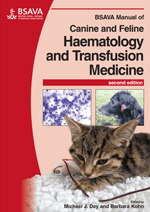
Full text loading...

The major innovations in small animal haematology in the last few years have been the introduction and wide application of laser-based counting systems, flow cytometry, immunolabelling and digital imaging. This chapter looks at blood sampling; basic quantification techniques; automated quantification techniques; blood cell morphology and interpretation; interpreting and haematological profile.
Introduction to haematological diagnostic techniques, Page 1 of 1
< Previous page | Next page > /docserver/preview/fulltext/10.22233/9781905319732/9781905319732.1-1.gif

Full text loading...





















